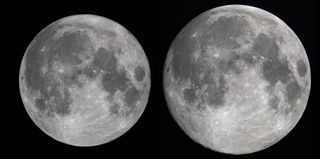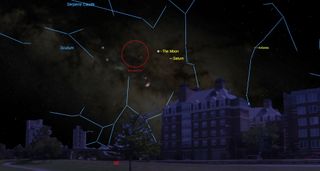Full Strawberry 'Minimoon' Shines with Saturn Tonight! What to Expect
This evening brings us the June full moon. And because strawberries are the first fruit after rhubarb to ripen in late spring and early summer — and the peak season (some might call it the "more natural" season) for picking strawberries is June — the traditional moniker for the June moon is Strawberry Moon.
There is another name that we could assign to tonight's full moon: "minimoon." That’s because this month's full moon will be the smallest in 2017. We're all, of course, familiar with the branding of supermoon, when the full moon coincides (or very nearly so) with perigee — that point in the moon's orbit when it is closest to Earth. On such occasions, the moon appears somewhat larger than normal because of its closeness to Earth.
Well, tonight's (June 9) moon is the opposite of that circumstance; a full moon that nearly coincides with apogee, the moon's farthest point from Earth.[The Moon: 10 Surprising Lunar Facts]
In the very strictest sense, when you look at the moon on Friday, it will not be at its farthest point from Earth. That moment actually occurred on Thursday (June 8) at 6:30 p.m. EDT (2230 GMT), when the moon was 252,526 miles (406,401 kilometers) from Earth. The moment of full moon comes 14 hours and 40 minutes later, at 9:10 a.m. EDT (1310 GMT) on Friday morning.
For what it's worth, the moon will have moved 81 miles (131 km) closer to Earth, compared with the actual moment of apogee the previous evening.
And when the moon "officially" turns full, it will not even be visible at that time across the contiguous United States, since it will have already set some hours before. Indeed, when you gaze up at the moon tonight it will not be "full," but 99.5-percent of full — a waning gibbous moon.

Because the moon is practically at its apogee point, it is also moving slowest in its orbit. And the "defect of illumination" — that is, the apparent change in reflected sunlight on the moon's disk — changes more slowly than normal. [How to Photograph the Moon: Astrophotography Tips]
Get the Space.com Newsletter
Breaking space news, the latest updates on rocket launches, skywatching events and more!
In fact, the moon will be at least 98-percent illuminated on four consecutive evenings: June 7, 8, 9 and 10. So from Wednesday through Saturday of this week, a casual observer who is not looking carefully at the moon would probably say that it looked full, since the defect of illumination is so slight. In contrast, when the full moon is near perigee, the change is more evident. Within 24 hours of full phase, even a casual observer would note the moon appearing slightly "out of roundness."
Incidentally, our friends at Spaceweather.com prefer to call a moon that coincides with apogee a "micro moon." From personal preference, I prefer "minimoon." The prefix "micro" is defined as "extremely small," whereas "mini" denotes a "miniature version." I think mini serves this purpose better than micro.
But one thing to remember: Unless you know in advance that the moon is either farther or closer than average, you really won't notice the change in size all that much (often said to be as much as 14 percent, but actually is closer to 12 percent).
Saturn shines, too!
Even if you don't immediately notice the moon being unusually small on Friday, one thing you will immediately notice is the bright planet nearby: the "ringed wonder" of the solar system, Saturn.
Weather permitting, you should be able to readily see Saturn glowing sedately like a very bright yellow-white "star" to the moon's lower right. Right now, Saturn shines at magnitude 0.0, making it a tad brighter than bluish-white Vega and a trifle dimmer compared with orange Arcturus.
Saturn appears so bright in part because it's less than a week away from its opposition to the sun; that moment during a particular apparition when a planet beyond Earth’s orbit is passing closest to us. [The Brightest Planets in June's Night Sky]

Another reason for Saturn appearing brighter than usual is the fact that its amazing rings are tilted almost at their maximum toward Earth; an inclination of 26.5 degrees. The rings, composed of highly reflective particles of ice, serve to bolster Saturn's apparent brightness. In March 2009, when the rings appeared nearly edgewise from our perspective, Saturn appeared half a magnitude dimmer than it does now.
The rings can be discerned with any telescope using an eyepiece of 30-power or more. Through a 4-inch telescope, employing a magnification of 100-power, the rings can clearly be seen; with a moderately large instrument of 8-inch aperture at 200-power the view is breathtaking, while viewing Saturn through a 12-inch telescope at 300-power is a jaw-dropping experience whether you’re seeing it for the first or thousandth time.
Check out this moon illusion

Tonight, Saturn and the moon will be separated by about 2.5 degrees. Considering that the moon measures a half degree across, you might assume that in the sky you'll be able to mentally image at least five full moons in the gap that separates them. And yet, visually they will appear much closer.
In fact, seemingly the gap might appear only about half that distance. That's because to the eye the moon appears twice its actual size, appearing to subtend a full 1 degree as compared to its actual size of half a degree. So in the sky tonight, it will appear that you'd only be able to squeeze two … maybe three moons between Saturn and the full moon, but certainly not five. [The Moon Illusion Explained]
The illusion is not confined to the real sky, but the "pretend universe" of the planetarium as well. When the very first Zeiss planetarium projector was built in 1923, both the sun and moon projectors were made to project their images equal to one-half degree as they appeared in the real sky. Except it was found that they appeared too small to look realistic although they were the correct size; the first planetarium moon indeed truly looked like a mini moon!
So the Zeiss engineers decided to increase the projected image size of the sun and moon to 1 degree on the dome. Here is one of the few places where accuracy was sacrificed for the same of realism.
And yet, if you take a picture of the moon with Saturn tonight, the moon's disk will appear very small and you would indeed be able to visualize five moons between the two. What your eyes see as an optical illusion, the camera lens does not!
Another sweet name for the Strawberry Moon
In recent years, the June full moon has also been referred to as the Honey Moon. This particular branding comes from Guy Ottewell, who for over four decades published the perennial "Astronomical Calendar." It would seem that weddings are scheduled in June more than any other month and that in June, the full moon's position in the sky places it close to the sun's place at the time of the winter solstice.
This makes sense because when the moon appears "full" it always appears diametrically opposite to the sun's position in the sky. The sun is now approaching the summer solstice, its highest point in the midday sky; correspondingly, the full moon is near the sun's low point — the winter solstice — so it appears to take a low journey across the southern part of the sky.
Ottewell notes: "Suggestions about the origin of the word honeymoon include the drinking of mead (honey wine) by the wedded couple every day for a month in some European countries. Honey is also a term of endearment, dating as least as far back as the year 1350; a corruption of hymenae, the Greek wedding songs."
But because from a visual standpoint, the June moon's low trajectory takes it through the lowest part of the atmosphere, its light is attenuated and tends to appear more amber or golden yellow — resembling the color of honey.
"Hence," notes Ottewell, "in June we have the 'Honey Moon.'"
Joe Rao serves as an instructor and guest lecturer at New York's Hayden Planetarium. He writes about astronomy for Natural History magazine, the Farmers’ Almanac and other publications, and he is also an on-camera meteorologist for Fios1 News in Rye Brook, NY. Follow us @Spacedotcom, Facebook and Google+. Original article on Space.com.
Join our Space Forums to keep talking space on the latest missions, night sky and more! And if you have a news tip, correction or comment, let us know at: community@space.com.

Joe Rao is Space.com's skywatching columnist, as well as a veteran meteorologist and eclipse chaser who also serves as an instructor and guest lecturer at New York's Hayden Planetarium. He writes about astronomy for Natural History magazine, the Farmers' Almanac and other publications. Joe is an 8-time Emmy-nominated meteorologist who served the Putnam Valley region of New York for over 21 years. You can find him on Twitter and YouTube tracking lunar and solar eclipses, meteor showers and more. To find out Joe's latest project, visit him on Twitter.
Most Popular


